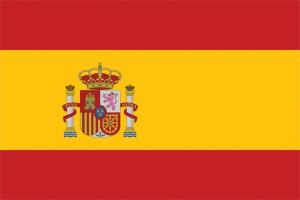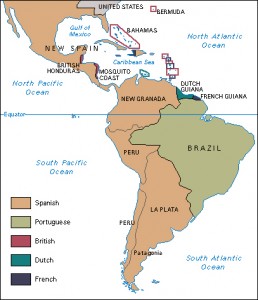Language Monday: Spanish
Monday, February 26th, 2018February 26, 2018
Spanish (español) is by some estimates the second most spoken language in the world, after Mandarin Chinese. More than 400 million people speak Spanish as their native tongue. Adding people who speak Spanish as a second language and those with partial fluency, the number nears 500 million. Spanish is the official language of Spain and most countries of Latin America. Spanish is also an official language in western Africa’s Equatorial Guinea and in the United States commonwealth of Puerto Rico. According to the U.S. Census Bureau, about 40 million U.S. residents spoke Spanish in 2016. Spanish is also an official language of the United Nations. Spanish has a rich literary heritage of celebrated drama, poetry, and prose. The Nobel Prize in literature has been given to 11 writers from Spanish-speaking countries since the prize first was awarded in 1901.

The Spanish language originated in Spain (the Spanish flag is seen here) and is the official language of numerous countries around the world. Credit: © Loveshop/Shutterstock
The Spanish spoken in Spain often is called Castilian Spanish (Castellano), after the historical kingdom of Castile. The Spanish of Latin America is known as American Spanish (español americano). Castilian and American Spanish are basically the same but differ in some vocabulary and pronunciation. Variations in the language also exist between different countries and regions of Latin America. For example, the writing instrument pen is bolígrafo or pluma in Spain, but it can be lápiz pasta in Chile, birome in Paraguay, and lapicera in Argentina. Yet no one will be confused if you ask to borrow a bolígrafo in Colombia or Peru.

Click to view larger image
Languages of the New World, including Spanish, are a result of colonial settlement by European nations. This map shows colonial territories of Latin America around 1790. Credit: WORLD BOOK map
As a language, Spanish is extremely phonetic, meaning that its pronunciation closely follows its spelling. It has only five basic vowel sounds, represented by the letters a, e, i or y, o, and u. Overall, the alphabet has 27 letters. Before 2010, there were 29, but the Royal Spanish Academy in Madrid declared two letters, ch and ll, non-letters that year. The decision caused some controversy throughout the Spanish-speaking world.
Spanish is part of the Indo-European language family—that is, a group of languages descended from a common proto- or parent language. The Indo-European family is the most prominent language family. It includes many of the languages of Europe, as well as languages of India. Within the Indo-European family, Spanish is a Romance language, along with French, Italian, Portuguese, Romanian, and several others. Such languages developed from the Latin language of the ancient Romans. Spanish and other Romance languages developed from the vulgar or vernacular form of Latin spoken by the common people.
During the 200’s and 100’s B.C., Romans conquered the Iberian Peninsula, home to modern-day Spain and Portugal. The Iberian people gradually adopted the Latin language. In A.D. 711, Arabic-speaking Muslims from northwestern Africa conquered most of Iberia. They ruled the region until the mid-1200’s. About 700 Arabic words were added to vulgar Latin, but the overall language changed little. Spanish began to emerge as an independent language during the period from 950 to 1000. It developed several dialects (related varieties). Castile gained significance in the 1200’s, and the Castilian dialect became the accepted form of Spanish in most of the region. Another dialect, Galician-Portuguese, became the basis of the Portuguese language. The Catalan dialect grew into the modern Catalan language of northeastern Spain.



